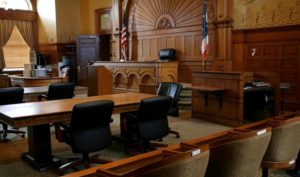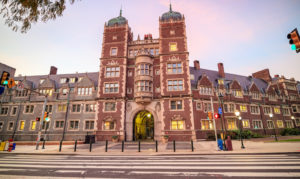
Scholars argue that state trial judges should lead efforts to deregulate legal representation.
The United States possesses one of the highest concentrations of lawyers in the world, so why do so many people in the United States lack access to affordable legal services?
That is the question presented in a recent article by four legal experts, who point out that three quarters of all state civil cases in the United States involve parties without counsel. These experts argue that the legal profession’s unique power to hold a monopoly on the provision of legal services—a power created by state supreme courts and bar associations—has priced legal services out of reach for 85 percent of U.S. citizens.
The article—authored by Jessica K. Steinberg of the George Washington University Law School, Anna E. Carpenter of the University of Utah’s S.J. Quinney College of Law, Colleen F. Shanahan of Columbia Law School, and Alyx Mark of Wesleyan University—points to the lawyers’ monopoly as a key factor perpetuating economic hardship and racial injustice. By prioritizing legal services for large, multinational corporations that have the ability to pay, the lawyers’ monopoly fails to address the legal needs of low-income families, middle-income individuals, and small businesses.
As a result, some trial court judges facing lawyerless courtrooms have come to rely on nonlawyer professionals who fill the role of attorneys, breaking the lawyers’ monopoly. Steinberg and her coauthors argue that nonlawyers perform critical work by drafting pleadings, providing substantive and procedural information to litigants, and offering counseling services.
Steinberg and her coauthors suggest, however, that the institutional pressure for judges to maintain the appearance of impartiality encourages concealing their partnership with nonlawyers from public view. Because judges are bound by ethical rules that demand impartiality, Steinberg and her coauthors hypothesize that the ethical constraint of judicial impartiality silences judges from actively speaking out about the importance of nonlawyer advocates in the courtroom.
Steinberg and her coauthors argue that, if state supreme courts and bar associations redefined the principle of judicial impartiality to capture the critical function of nonlawyers, state trial judges could lead the development of best practices around the use of nonlawyers in the courtroom. Because of their close partnership with nonlawyers, state trial judges are in the best position to design nonlawyer programs that uphold the integrity of the legal profession, fill the justice gap for ordinary U.S. citizens, and open a pathway for a new class of legal professionals.
Proponents of attorney control over the provision of legal services, however, argue that the lawyers’ monopoly best protects consumers against fraudulent actors and ensures quality control of legal analysis and representation. They also claim that, since nonlawyers lack the ethical oversight and disciplinary structures of state supreme courts and bar associations, nonlawyers are not qualified to render counsel.
Opponents of regulatory reform often cite the state of Washington’s attempt to create a robust paraprofessional class in 2012, which was the first of its kind in the United States. The formal program authorized nonlawyer advocates to practice in specific areas such as immigration and family law.
But after seven years, the Washington Supreme Court shuttered the initiative in light of a lack of participation and overall costs. For Steinberg and her coauthors, the program failed due to significant barriers to entry, including strict educational requirements and a 3,000 hour of attorney-supervised work requirement prior to participation in the program.
Despite the failure of the Washington program, Steinberg and her coauthors still see the merits of nonlawyers performing tasks usually reserved for attorneys in the courtroom. Following a two-year study of domestic violence courts, Steinberg and her coauthors assert that nonlawyer advocates successfully perform a range of legal advocacy work, including drafting protective order petitions, counseling pro se petitioners, developing factual evidence, and even influencing judges’ performance in the courtroom.
Furthermore, Steinberg and her coauthors suggest that nonlawyer advocates serve two critical purposes in domestic violence courtrooms. First, nonlawyer case preparation aids trial court judges in managing their dockets, for which judges are under significant pressure to process quickly. Second, nonlawyer-crafted petitions pinpoint the legal bases for protective orders, preventing judges from stepping outside the ethical boundaries of their position to assist pro se parties in advancing their claims.
Recently, at least a dozen state bar associations and supreme courts have formed task forces to explore ways to crack open the lawyers’ monopoly. Leading the charge in regulatory reform, the Utah Supreme Court created a “regulatory sandbox,” which permits nontraditional entities, co-owned by lawyers and nonlawyers, to deliver legal services. In May 2020, the California State Bar Board of Trustees voted to explore similar reforms to expand access to affordable legal assistance.
In addition, several states are enacting plans to create new forms of licensure for legal paraprofessionals who have not attended law school or passed a state bar exam. For example, under a licensed paralegal program in Utah, licensees may assist clients in family law, eviction, and debt collection cases. In Arizona, a legal paraprofessionalism program permits licensees to provide some forms of legal advice to domestic violence survivors.
For Steinberg and her coauthors, states’ efforts to deregulate the lawyers’ monopoly mark the most dramatic reexamination of the lawyers’ monopoly in decades. For that reason, Steinberg and her coauthors recommend that state supreme courts and bar associations consider the needs of ordinary people in debating whether to dismantle the lawyers’ monopoly and how to craft a regulatory framework around nonlawyer advocates in the courtroom.
By leveraging their experiences, trial court judges and nonlawyer advocates stand in the best position to formulate new categories of legal paraprofessionals that fill the United States’ critical justice gap and address lawyers’ concerns of quality control and consumer protection, according to Steinberg and her coauthors.



